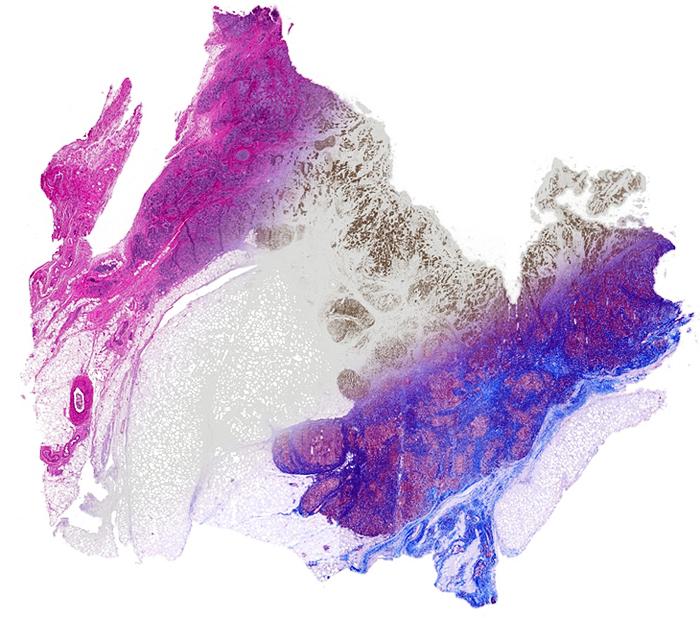

Breast tissue is computationally stained using data from infrared imaging without actually staining the tissue, enabling multiple stains on the same sample. From left, the image shows a Hematoxylin and Eosin stain (pink-blue), molecular staining for epithelial cells (brown color) and Masson's trichrome(blue, red at right).
Credit: Rohit Bhargava, University of Illinois
Using a combination of advanced microscope imaging and computer analysis, the new technique can give pathologists and researchers precise information without using chemical stains or dyes. Led by Rohit Bhargava, U. of I. professor of bioengineering and member of the Beckman Institute for Advanced Science and Technology, the researchers published their findings in the journal Technology.
“Any sample can be analyzed for desired stains without material cost, time or effort, while leaving precious tissue pristine for downstream analyses,” Bhargava said.
To study tissue samples, doctors and researchers use stains or dyes that stick to the particular structure or molecule they are looking for. Staining can be a long and exacting process, and the added chemicals can damage cells. Doctors also have to choose which things to test for, because it's not always possible to obtain multiple samples for multiple stains from one biopsy.
The new, advanced infrared imaging technique uses no chemical stains, instead scanning the sample with infrared light to directly measure the chemical composition of the cells. The computer then translates spectral information from the microscope into chemical stain patterns, without the muss or fuss of applying dyes to the cells.
“We're relying on the chemistry to generate the ground truth and act as the 'supervisor' for a supervised learning algorithm,” said David Mayerich, first author of the study. Mayerich was a post-doctoral fellow at the Beckman Institute and now is a professor at the University of Houston. “One of the bottlenecks in automated pathology is the extensive processing that must be applied to stained images to correct for staining artifacts and inconsistencies. The ability to apply stains uniformly across multiple samples could make these initial image processing steps significantly easier and more robust.”
The researchers reproduced a wide array of molecular stains by computationally isolating the spectra of specific molecules. This allows the user to simply tune to a required stain, for as many different stains as are necessary – all without damaging the original tissue sample, which can then be used for other tests.
“This approach promises to have immediate and long-term impact in changing pathology to a multiplexed molecular science – in both research and clinical practice,” Bhargava said.
###
The National Institutes of Health supported this work. The Carle Foundation Hospital in Urbana, Illinois, and the University of Illinois Cancer Center at the University of Illinois at Chicago were partners in this work.
Editor's note: To reach Rohit Bhargava, call 217-265-6596; email: rxb@illinois.edu.
The paper, “Stain-less staining for computed histopathology,” is available online.












